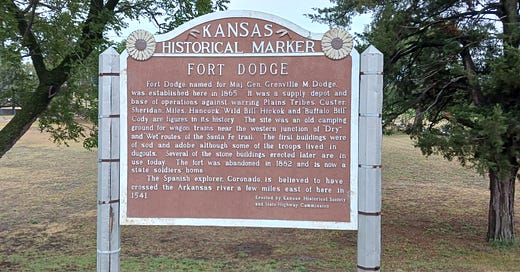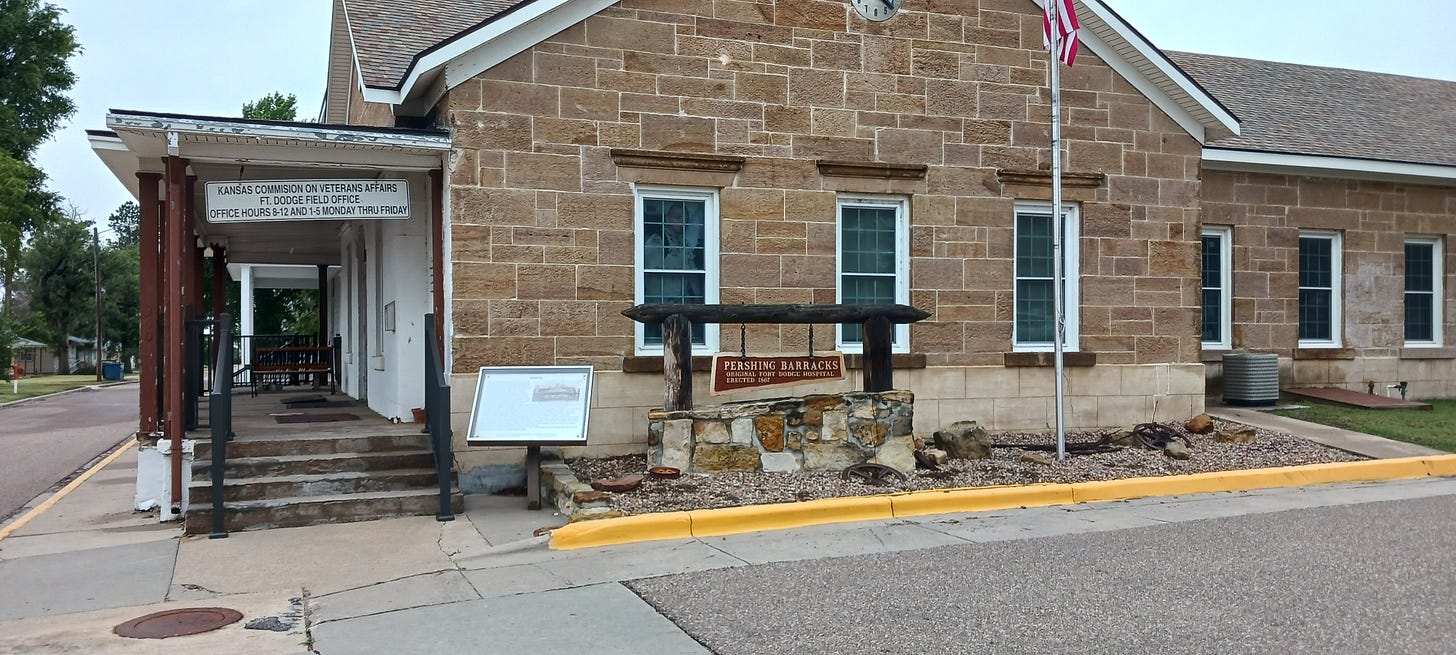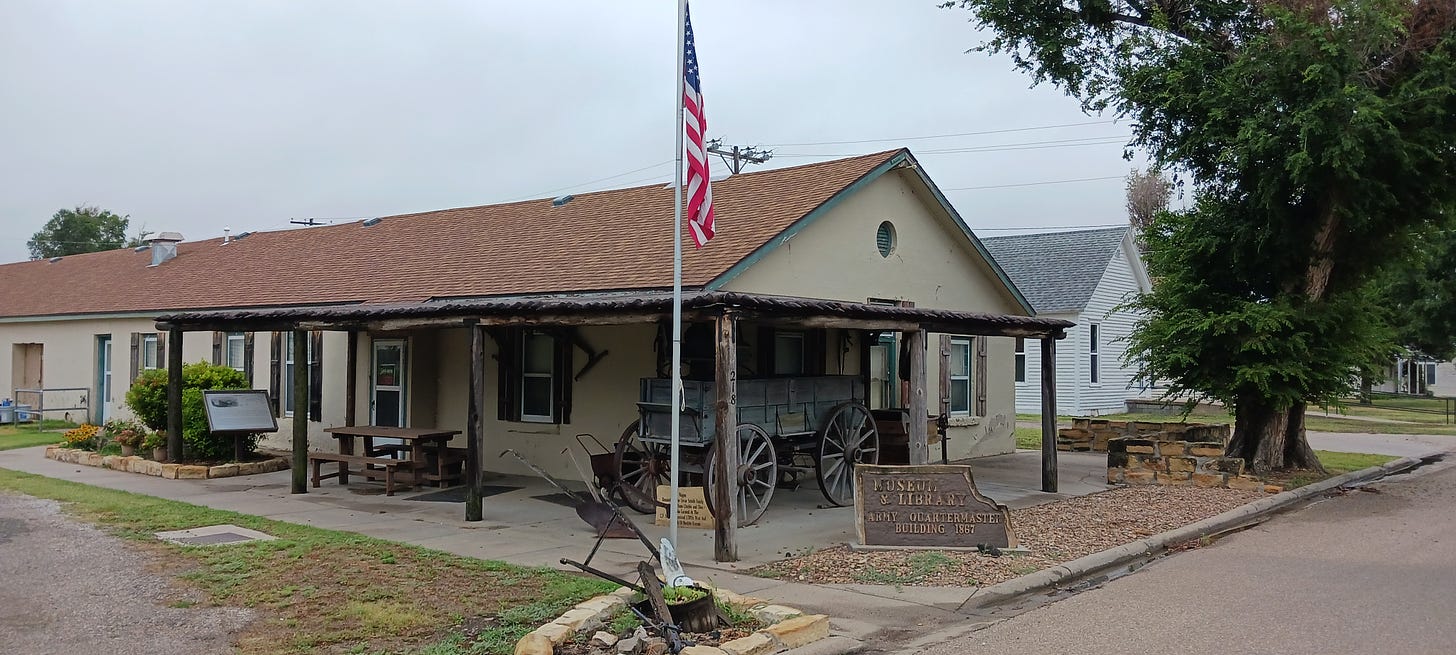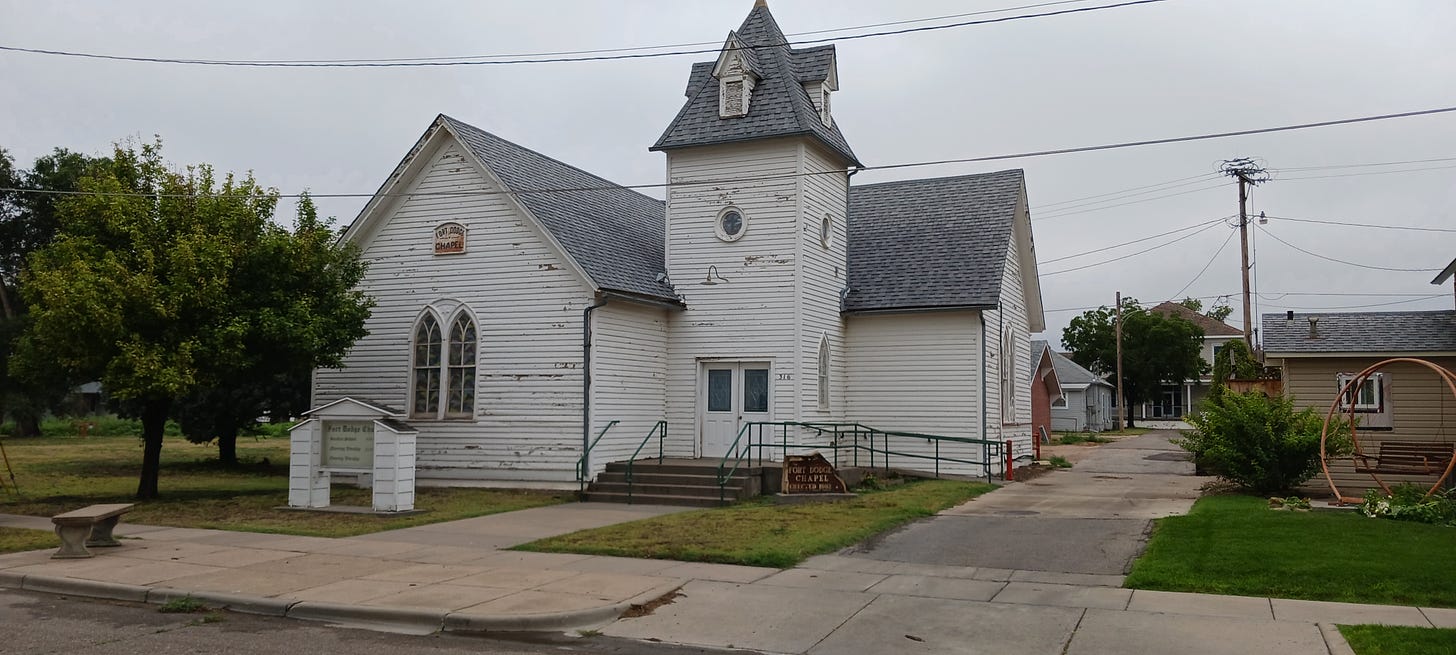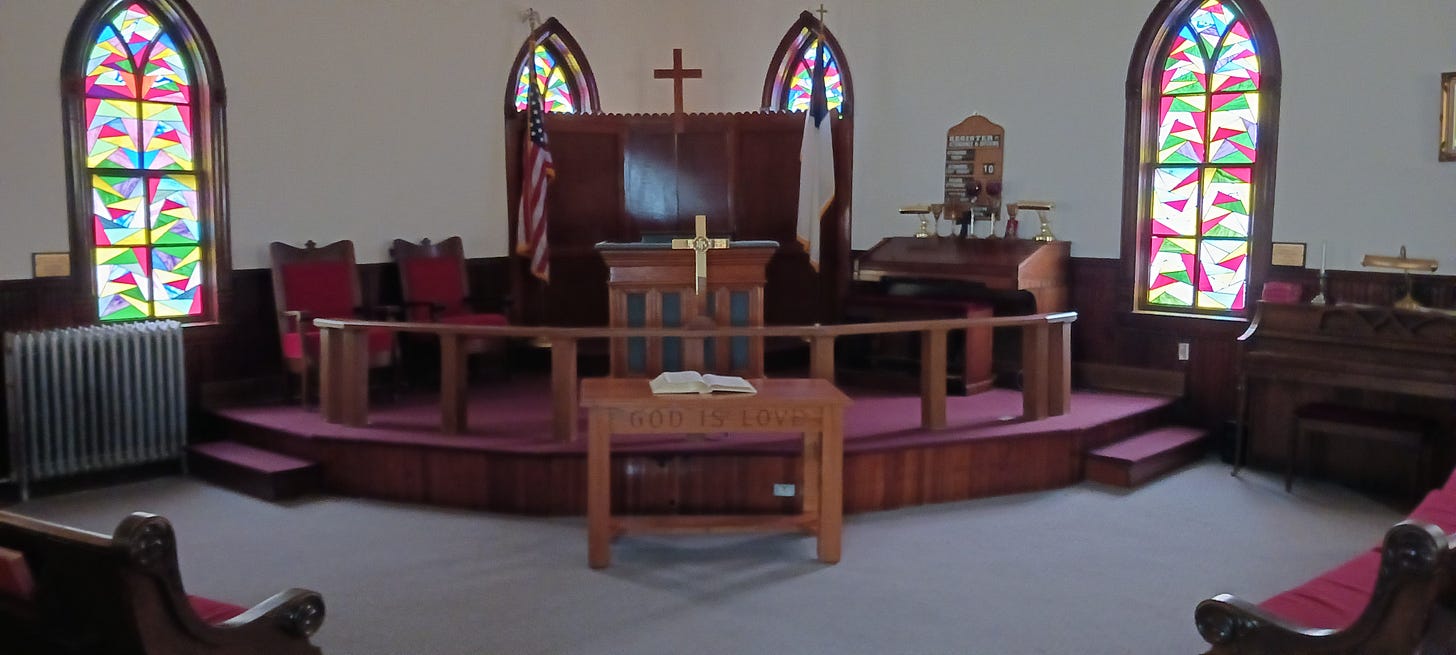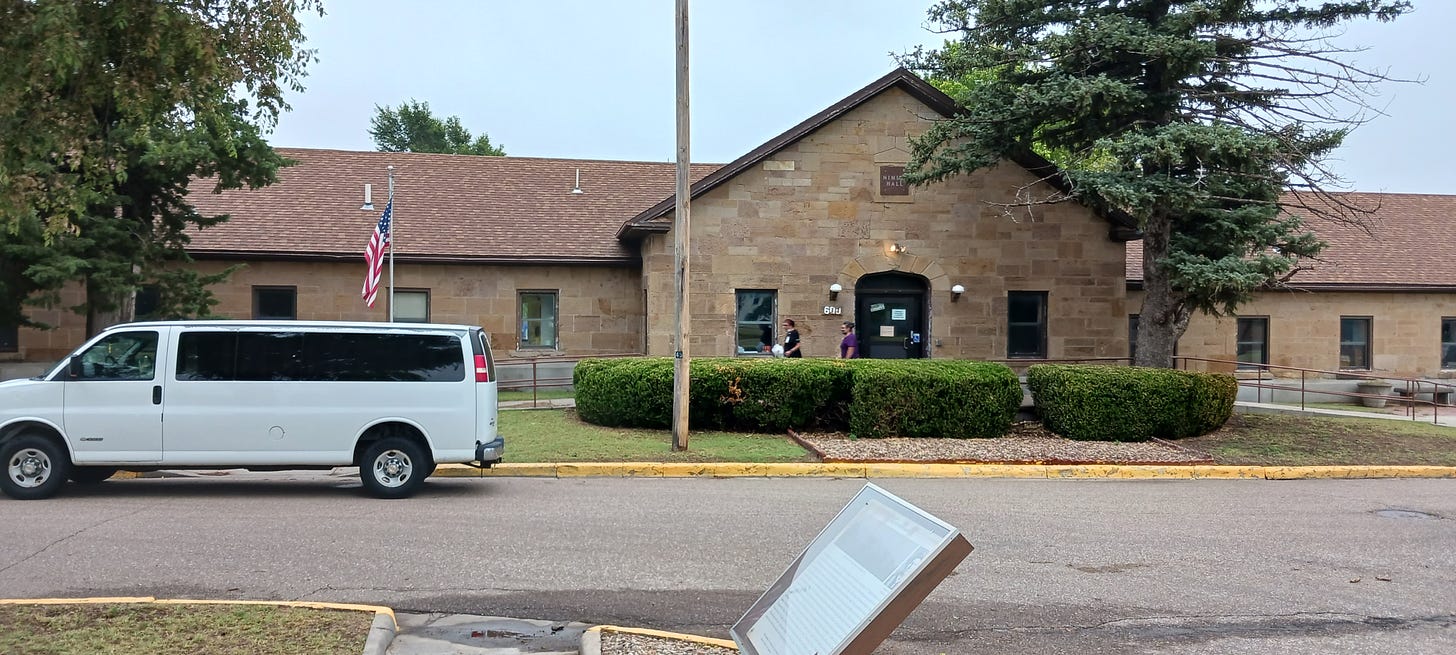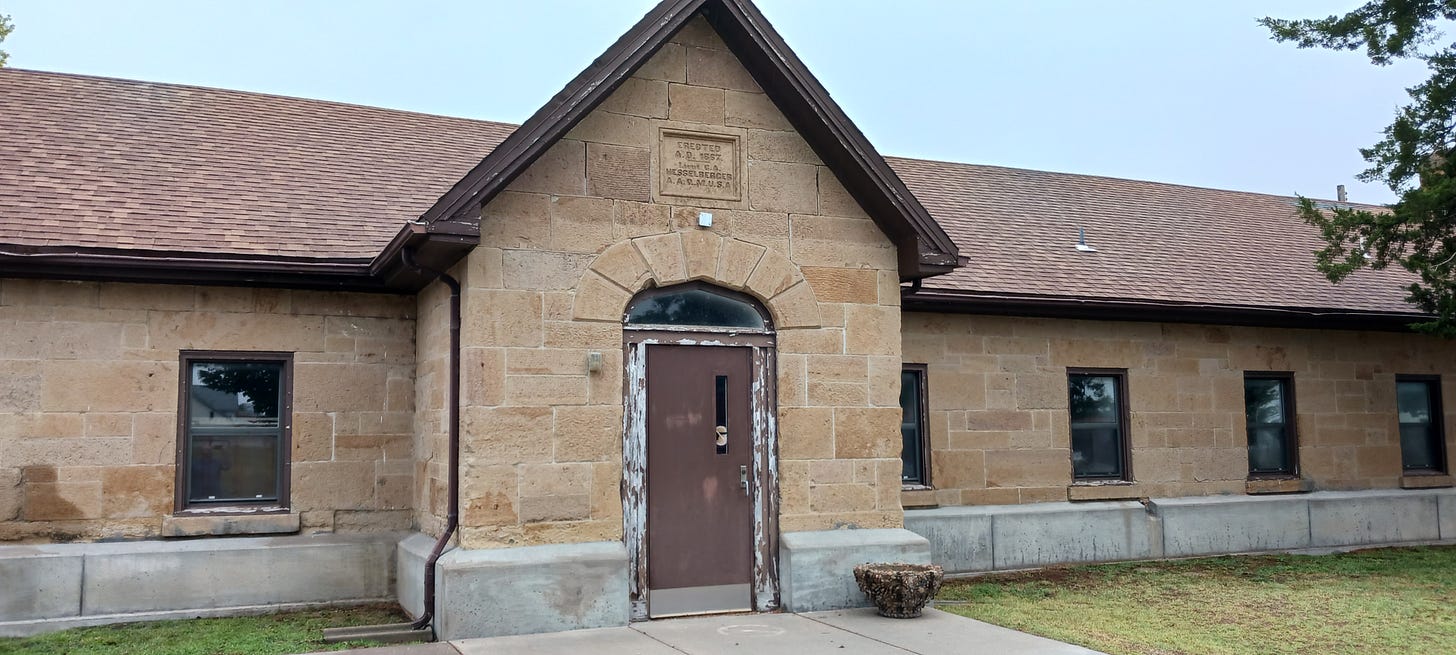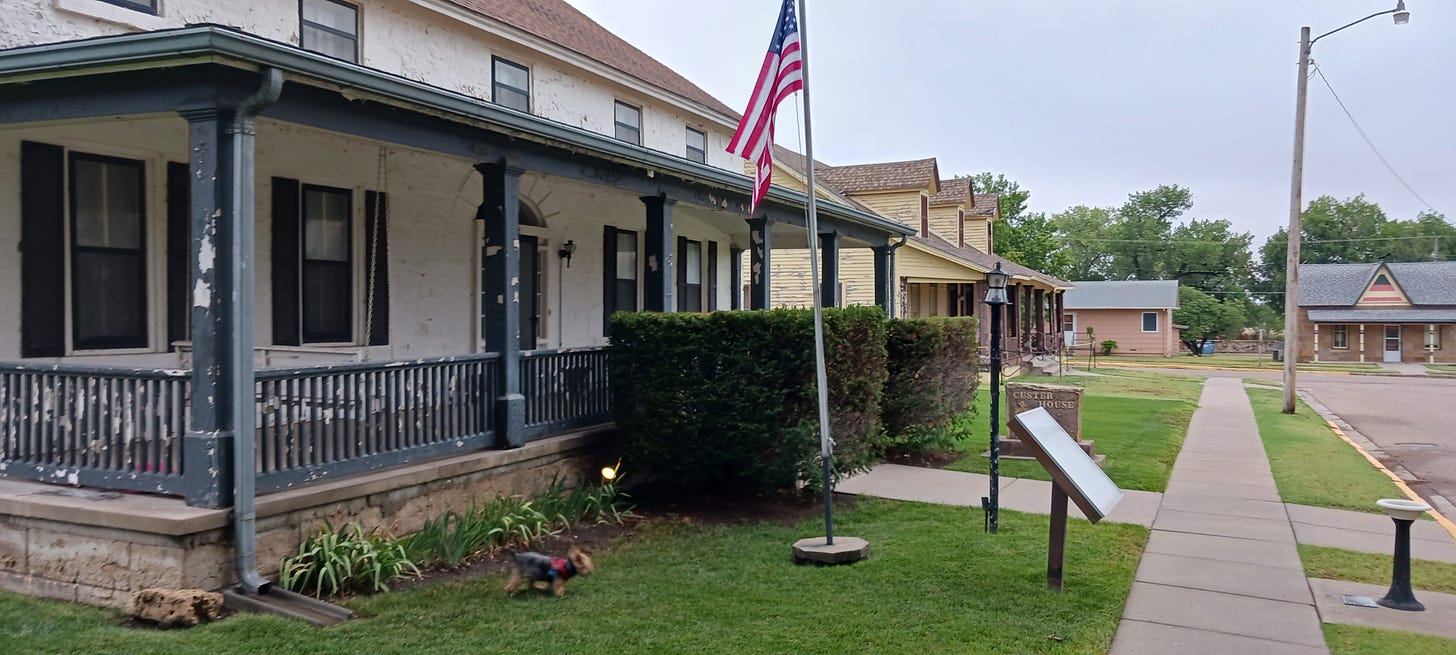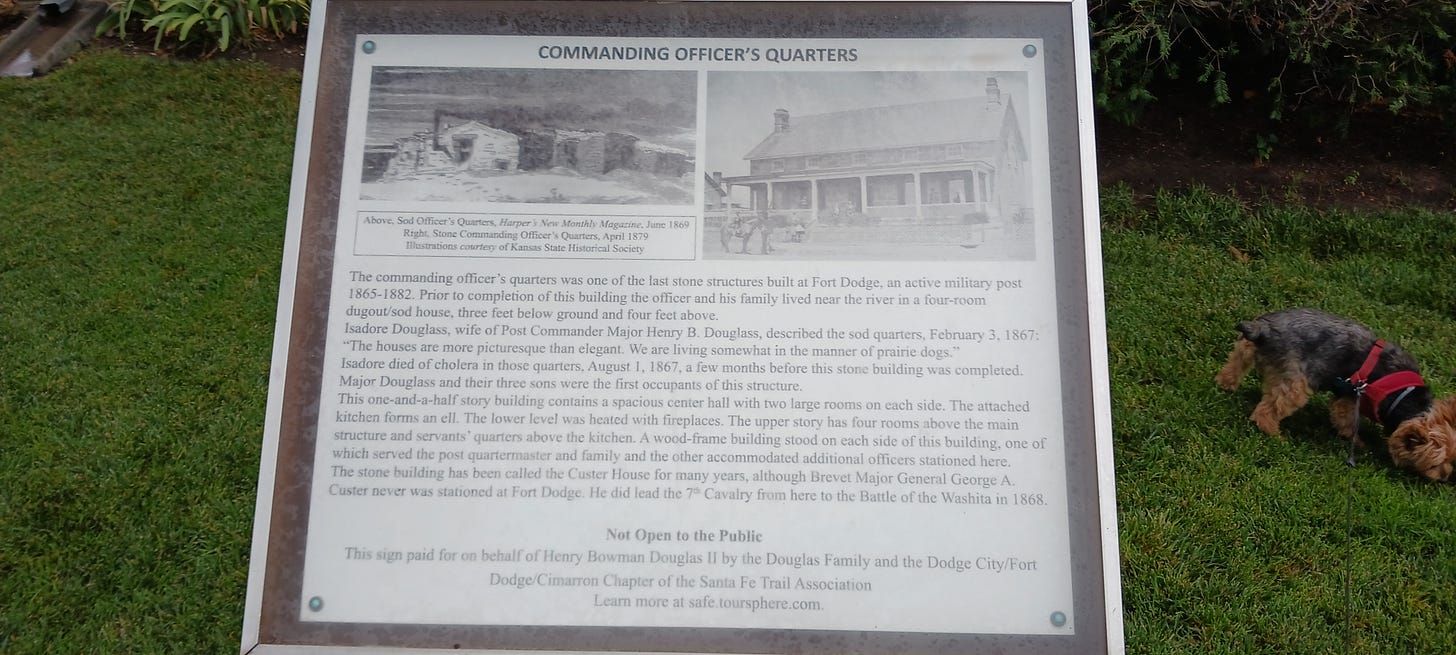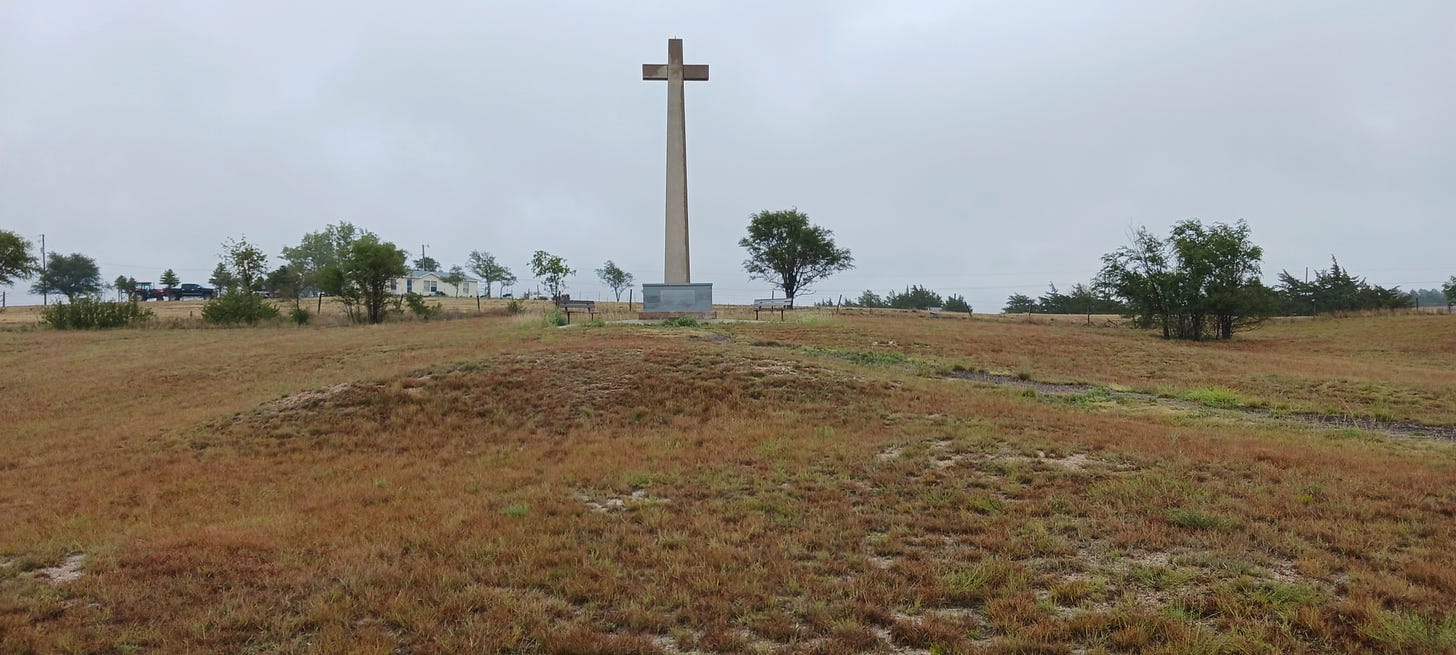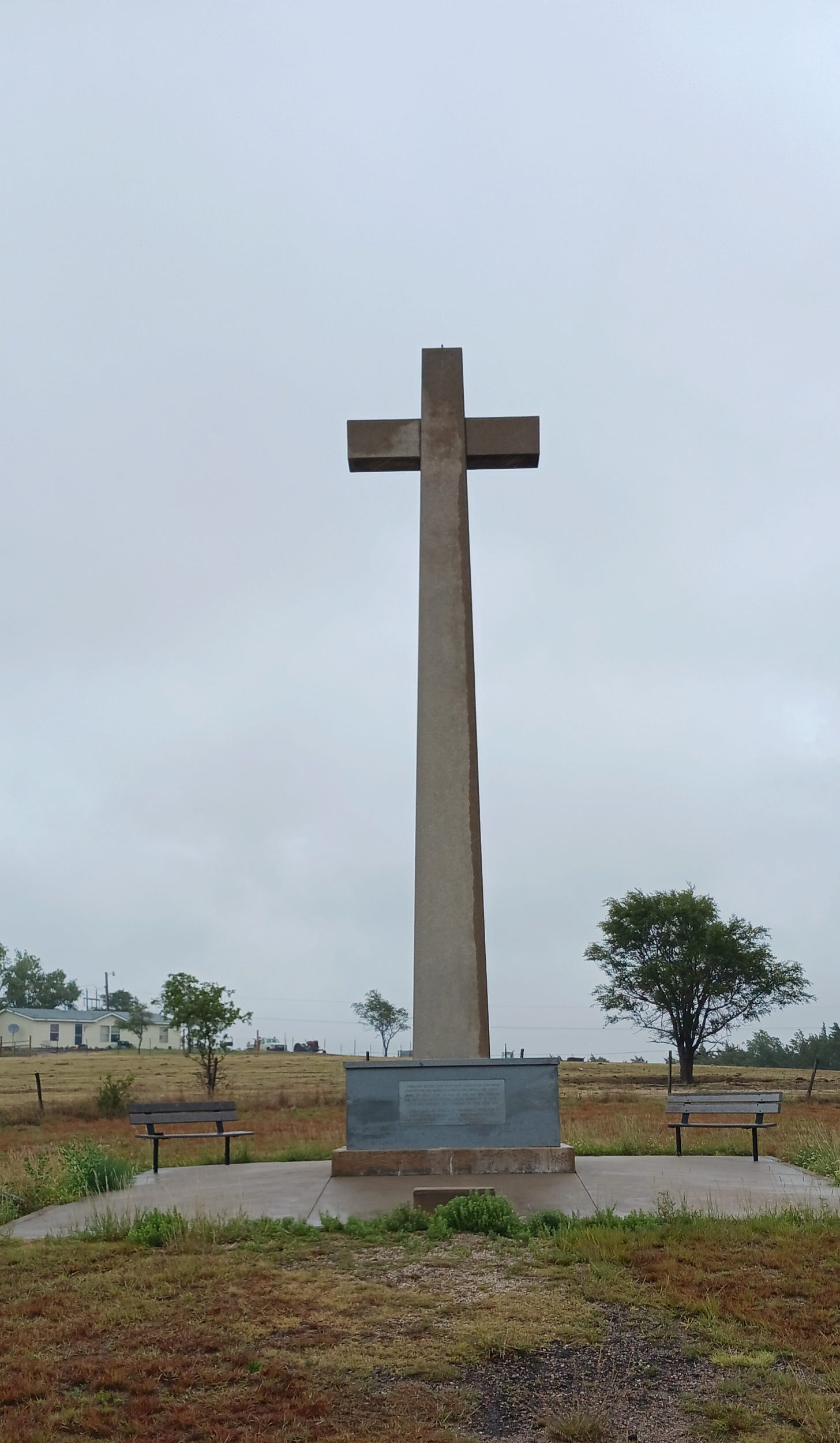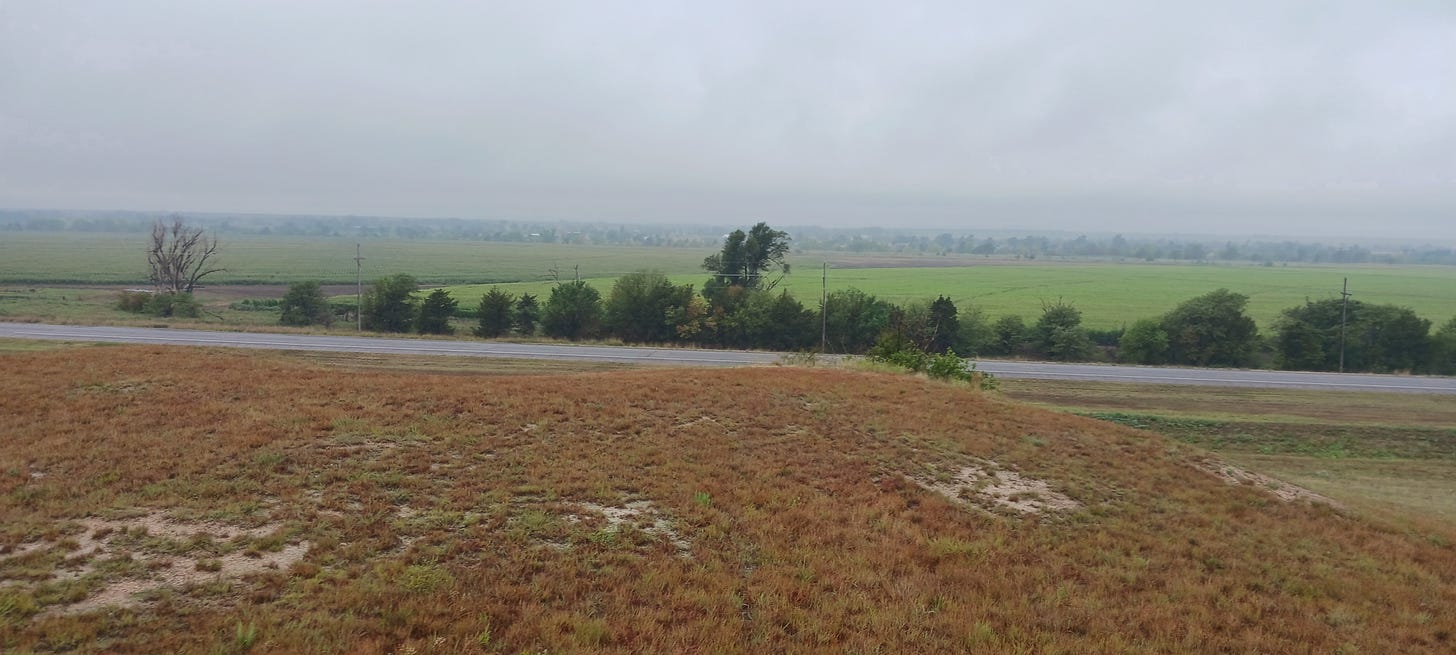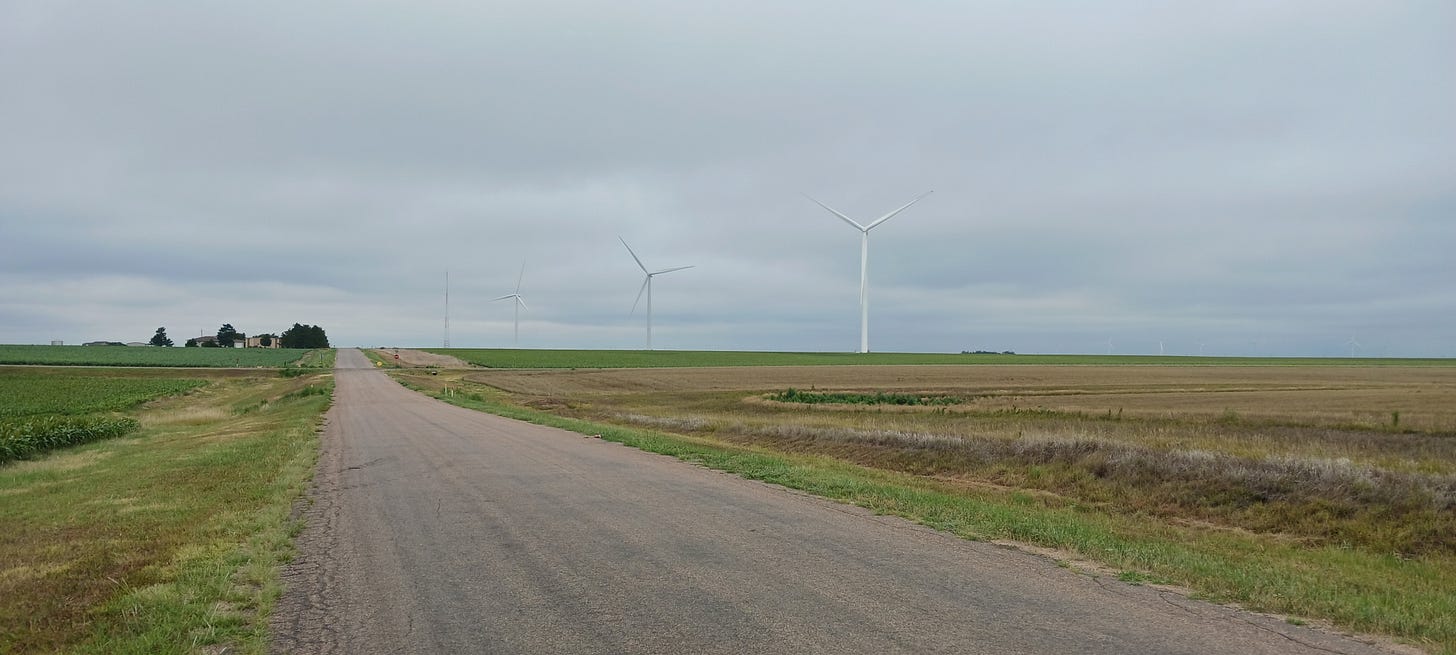Dodge City Days III: Fort Dodge & the Coronado Cross
The Start of the Third Day in Dodge Was the Charm
This installment on my journey to Dodge City is abominably late, but setting up my home and getting used to a new job took longer than I had imagined. My vow is that the next entry will come in the next few weeks. Here are links to the first and second parts of the essay. —Darrick
The next morning, I was eager to get started, the rain having finally abated. I picked up donuts at a local shop the next morning, and headed out early to get a head start. The rain had cooled things off considerably: normally, Western Kansas is a ninety plus degree desert during the month of July, but as I loaded Gus into my CR-V, it was cool, damp and in the low 60s. This out-of-the-ordinary atmosphere gave me an auspicious feeling to start the day which I relished. First stop on the itinerary: Fort Dodge.
As the sign says, Fort Dodge was a supply depot during the wars with the Plains Indians following the Civil War, and many famous names, including that of George Custer, made their way through the fort at one point or another. In 1890, the state turned into a home for war veterans from Kansas, which it remains today.
The “Pershing Barracks” was the original hospital built in 1867 when the Fort opened. It now houses the admin offices of the Fort. According to information board near the steps, soldiers generally remained in “good health” during the Fort’s existence, despite primitive sanitation conditions.
The Fort was a key supply post with connections to the Santa Fe trail and later on the railroad. Its central location explains why so many famous generals passed through it. The old quartermaster’s house below is today the museum and library of the Fort.
Wherever I go, I always seem to find my way to the nearest church, especially if it looks old. I guess it is my innate antiquarianism, but I love old churches of any kind. The chapel at Fort Dodge, which sits across the street from the museum, was built in 1902, and seems to have been a Protestant, non-denominational affair from the looks of it.
It appeared a bit run down, and the interior proclaimed it to be one of those modest, Midwestern style buildings that supplied houses of worship for so many in the 19th and 20th centuries—Lutherans, Methodists, Presbyterians, the old “mainline” Protestant churches that have fallen on such hard times in the 21st (along with every other faith, it seems).
Walking around Fort Dodge that morning, with the air damp and wet, a slight mist of rain pelting my skin, was a strange experience. On Saturday morning in what was admittedly a retirement community, not a soul was stirring, even as I tramped with my dog through people’s back yards (unintentionally). The only other people I saw arrived in a white van and dropped someone off in front of the old barracks for enlisted men.
The most interesting building was not open to the public, the old officers quarters building, now dubbed “Custer House” even though Custer was never actually stationed there (though he did come through in 1868 after a battle, per the sign below).
I am not completely certain how long I tarried at Fort Dodge—perhaps an hour, maybe less—but I had a schedule to keep, and there was one spot not far from Fort Dodge I wanted see.
A five minute drive east down Route 400 takes you to Coronado Cross, a concrete monument erected in the 1970s for the National Bicentennial of 1976. It marks the spot (generally speaking—no one knows exactly) where the Spanish explorer Francisco Vasquez de Coronado crossed the Arkansas river just south of Dodge City in 1540. There, along with a Franciscan Friar named Juan Padilla, who offered a Catholic mass, they were likely the first Europeans to offer any kind of Christian worship in the interior of North America. We don’t often think of America as having a Catholic past, as it became a Protestant nation later during colonial times, but it has always had a “Catholic Fringe,” from California through the Gulf States and into Florida.
The woman that donated the land for the monument came from an old pioneer family whose ranch rested sat amonst the hills on which the cross is built. From the monument, you can view the prairie that sits between it and the Arkansas River to the south.
I let Gus roam around bit, taking in the scenery, before hopping back in the CR-V. The morning already felt promising, like the trip would deliver on those vague expectations of mine. That is when love travelling best, when it spontaneously provides experiences that alter your attention, how you see the world, however briefly.
As I made my way down Route 400, on the way to the next stop, I experienced one of those moments. Being from Florida, and living there now again, you get used the crush of people everywhere, the crowded bumper to bumper Interstate traffic, the constant flow of tourists. You take it for granted. But living in Kansas gave me a whole new perspective on population density, no more so than those few times I visited Western Kansas, where you measure the distance between towns in the tens of miles. I’m not sure when I realized it, but after a time it hid me that there were no cars on the road of any kind; I was all alone, just me and Gus.
As I came across some of those giant windmill farms, I suddenly felt the impulse to stop, just to experience what it was like, to be alone out there. I pulled over and let Gus out, and stood on the side of the road, letting the wind blow cool air over me as I listened to the sounds of those windmills turning over the plains.
Both of us loitered and paced in the middle of the street, completely unencumbered, Gus taking the time to sniff every patch of ground on both sides. My God, it was magnificent. I must have stood there ten or fifteen minutes, and never saw a single soul pass by. For a moment, I alone possessed the world, that world, all to myself. When I soaked up as much of that feeling as I could, I loaded Gus back in the car, and sped off on the next leg of the trip, this time an unplanned stop. We headed north to find a hidden gem I only noticed on the way into Dodge City—one of those usually suspicious “historical marker” signs—which turned out to be one of those lovely surprises that makes going out from one’s home so fulfilling and worthwhile.
